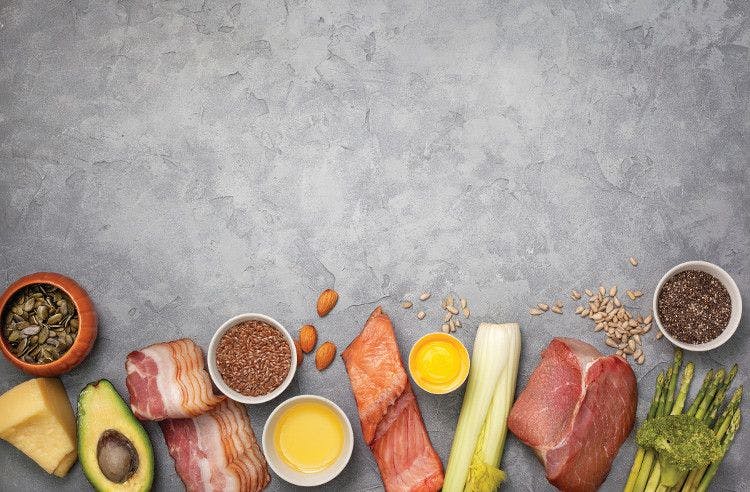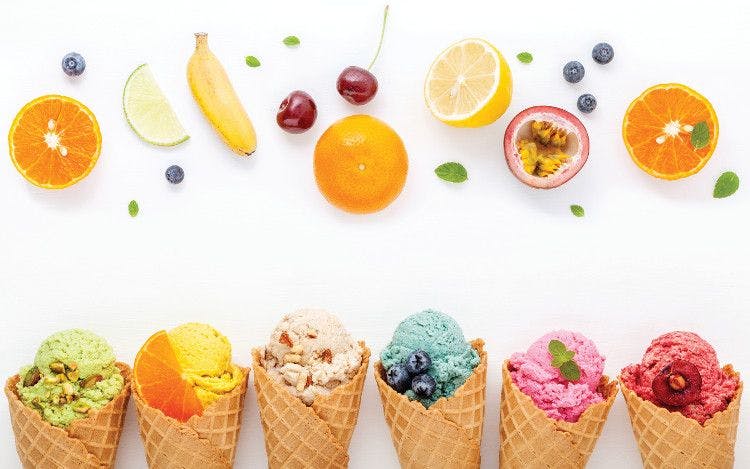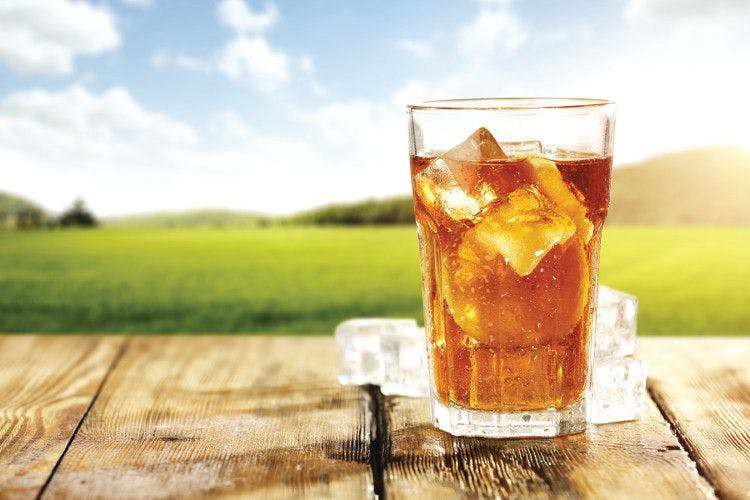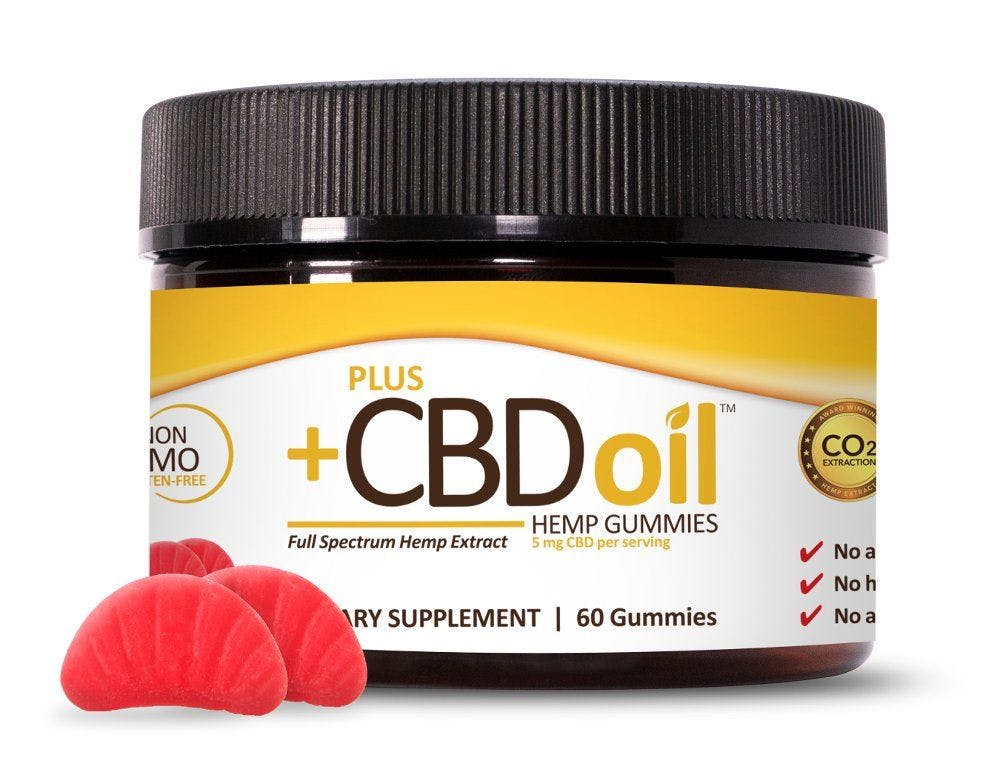Frozen desserts get healthy
We quizzed the experts on their top strategies for balancing wellness with “Wow!” in frozen desserts.
Image courtesy Kerdkanno - Stock.adobe.com
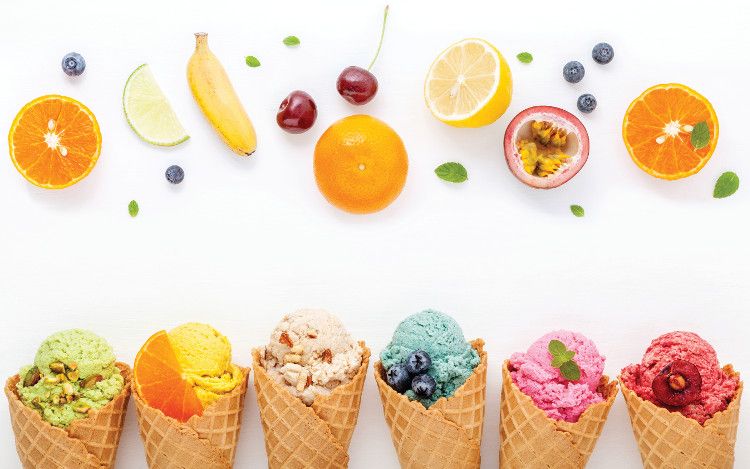
If you’re wondering why supermarket freezer cases give over ever more space to sumptuous, indulgently flavored treats that also happen to be low in sugar and calories, high in protein and fiber, and scrupulously clean of label, blame Halo Top.
Halo Top, of course, is the sweet sensation that broke the frozen-dessert mold with its healthful bona fides, 2500% growth, and $342.2 million in 2016 sales-elevating it to 2017’s top-selling new food brand, according to IRI data.
And that explains why Max Maxwell, manager, market intelligence, Glanbia Nutritionals (Chicago, IL), insists that “Halo Top was the tipping point, is the tipping point, and continues to be the tipping point. The healthy frozen-dessert category is poised to grow much further than it already has, and it largely began with Halo Top.”
The Halo Effect
As far as Maxwell is concerned, the reasons are obvious. “Halo Top delivers the combination of attributes consumers have shown they want: better for you, indulgent, great tasting, convenient, and no guilt,” he says. “Think about it: One whole pint of Halo Top is just 280 calories, and a consumer could eat any portion, including that whole pint, without feeling bad about it-in fact, feeling quite good because they’re getting protein while they enjoy it. And that could very well be the definition of ‘healthy’ in terms of what drives consumers’ purchase decisions today: guilt-free indulgence with added nutrition.”
The brand’s success has inspired-or pressured-other brands to follow suit with formulation “upgrades” that involve added protein or “clean” sugar reduction, all of which leaves Thom King, president and CEO, Icon Foods (Portland, OR), with the impression that the “Halo effect” is “spreading like wildfire.”
“Every dairy processor that makes desserts has to be looking at this category,” he says. Speaking from his own experience, he says his company’s fielded more clean-label sugar-reduction projects from frozen-dessert customers than from any other category in 2018, “and we do not see that pace slowing down going into 2019.”
Even retailers have noticed Halo Top’s success, Maxwell adds, with several introducing similar products in their stores in a bid for some of the brand’s healthy margins. “And when retailers get into the game,” he notes, “you know there’s something good going on.”
New Trends, New Formulations
Creamy, dreamy Halo Top is a far cry from the “healthy” frozen desserts of yore, which long ran to tired staples like ice milk and gummy-textured low-fat offerings. “The next wave after that was frozen fruit confections and frozen yogurt,” Maxwell recalls, “and none of these came close to the success of Halo Top. While some are still on the market and fill a consumer niche, the growth will likely be more in this indulgent, low-cal, high-protein space.”
Formulations are bridging the healthy-indulgent divide by introducing more of the positives consumers want-like protein-and eliminating or drastically trimming the negatives, like sugar and artificial anything.
“Currently, most brands are using dairy proteins, but that’s expanding into plant proteins,” Maxwell observes. “They’re taking out sugar, too, using alternatives like stevia or monk fruit, honey, and agave-type sweeteners as replacements. They’re also removing stabilizers, preservatives, artificial flavors, and colors and any ingredients that have more than a couple of syllables or sound like a chemical.”
As a sweetener supplier, Icon Foods’ radar is tuned to shifts away from nutritive sweeteners and chemically synthesized sugar substitutes to alternatives “that consumers can relate to,” King says. But they have to be functional in formulation, too-and many are. “Sweetener blends like stevia and erythritol as well as stevia and allulose lend freezing-point depression,” he says, which helps keep ice cream soft and scoopable, “and allulose really helps with overrun, making for a nice airy and fluffy ice cream.”
He’s also noticed a shift away from hydrocolloids like carrageenan to locust bean gum and natural hydrocolloid blends; indeed, he wagers that today’s hydrocolloids have advanced to the point that the mouthfeel, texture, and overrun of healthy frozen desserts “can be spot-on compared to traditional full-sugar versions,” he says.
Even ice cream inclusions are cleaning up their acts-thanks in part to companies like King’s. “The biggest gain for us is the development of our SweetBitz sugar-free inclusions for frozen desserts,” he notes. “We have sugar-free chocolate chips in 2-m and 4-m sizes. In Q2 of 2019, we’ll be adding inclusions such as sugar-free white chocolate chips, sugar-free butterscotch chips, sugar-free cookie bits, birthday-cake multicolored sprinkles, and more. Stay tuned!”
Having Their Ice Cream Cake and Eating It
It’s just another sign that no matter how high up the ranking “healthiness” rises, a frozen dessert is still a frozen dessert. So it had better 1) be fun, and 2) taste great.
Notes Terri Rexroat, vice president, team lead, Latin America, U.S. Dairy Export Counsel (USDEC; Arlington, VA), “Consumers are looking for healthier options in this category, but even with the demand for clean labels and convenience, taste is still king. Consumers won’t compromise flavor or texture, even for nutritional benefits. So the sweet spot for formulators is ‘healthy indulgence.’”
This even applies to the exalted Halo Top. “One of the factors that made Halo Top so successful was its healthier proposition,” Maxwell argues. “The brand calls out its high protein and low sugar on the label, which falls right in line with the macro consumer trends-it’s taking a traditionally indulgent product and makes it healthier. But what also makes it so successful is that it tastes good.”
Which is what this burgeoning category needs to keep growing. “If a healthier frozen dessert doesn’t taste good, it won’t be successful,” Maxwell concludes. “With so many brands competing for market share, consumers are in control of their choices and won’t tolerate poor-tasting frozen desserts.” Even if they have a halo on top.
We quizzed the experts on their top strategies for balancing wellness with “Wow!” in frozen desserts. Here are their tips.
Accentuate the Positives
Photo © iStockphoto.com/Maksud_kr
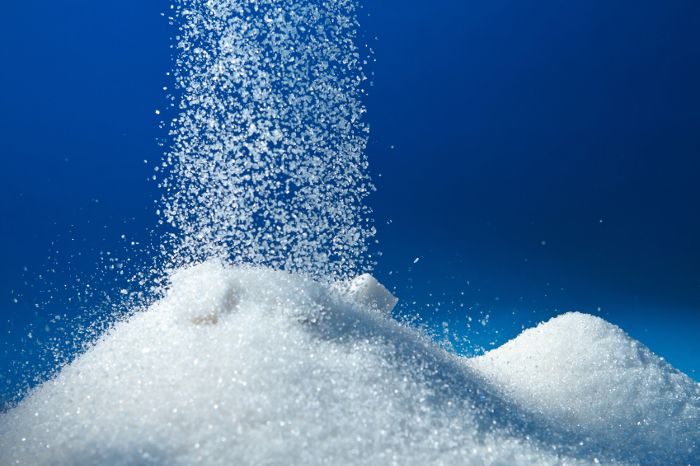
In the past, enjoying a healthy frozen dessert meant “giving up something to gain the benefit,” Glanbia’s Maxwell says-“with that something usually being taste.” The current trend, by contrast, “is toward not having to make any sacrifices, and indeed, to receive nothing but benefits.”
That means cutting out no-nos like added sugars and artificial sweeteners while loading on the pluses like protein and fiber. And it means that formulations have to maintain the taste, flavor profile, and texture that consumers will accept as indulgent.
“We think ‘positives’ have the most long-lasting beneficial impact on a product,” Maxwell concludes. “There are still the ‘nos’ and the ‘lows’ that work-no sugar, low sugar, no artificial ingredients. But the positives have a more powerful appeal, particularly as consumers seek help in making better choices. The ‘nos’ get your brand in the game, but it’s the positives, like high protein or good source of protein, that have great appeal.”
King couldn’t agree more. “As I see it,” he says, “there are no negatives, only positives.”
Photo © iStockphoto.com/AlasdairJames
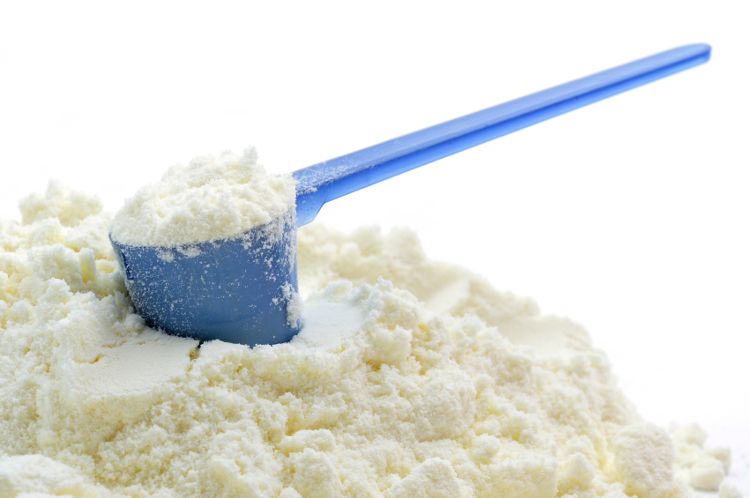
Protein on the Plus Side
Protein is clearly one of the plus-side ingredients that make category watchers bullish. And frozen dessert developers have their pick of proteins to formulate with.
“While milk and cream are typically used in ice cream and frozen desserts, additional fortification with dairy protein ingredients can boost nutrition to create consumer appeal,” says Rexroat. “Whey and whey protein ingredients have been used successfully in ice cream and other frozen dairy desserts for the past six decades. Sweet whey, whey protein concentrates at 24%-89% protein and whey protein isolates at 90% protein, are among the most commonly used whey products. Other whey ingredients, such as delactosed and demineralized whey, can also be used.”
To make protein-packed formulation even easier, King’s company launched its HiPro Ice Cream Dry Mix as “a plug-in solution to take the guesswork out of creating a superior product with fewer than 80 calories per serving,” he said.” A proprietary blend of milk protein concentrates, natural sweeteners, and natural gums and stabilizers, it produces a “home-style” ice cream with 5 g of protein and 8.3 g of carbs per serving.
The company even supplies a vegan version that King says is grabbing attention. And that makes sense to Maxwell, who notes that “what started with Halo Top in the frozen dairy space could well expand into plant-based frozen desserts. Imagine a pea protein- or bean protein-based dessert, maybe even with a probiotic. We’re just at the beginning of the growth and expansion of this category.”
Photo © iStockphoto.com/OlgaMiltsova
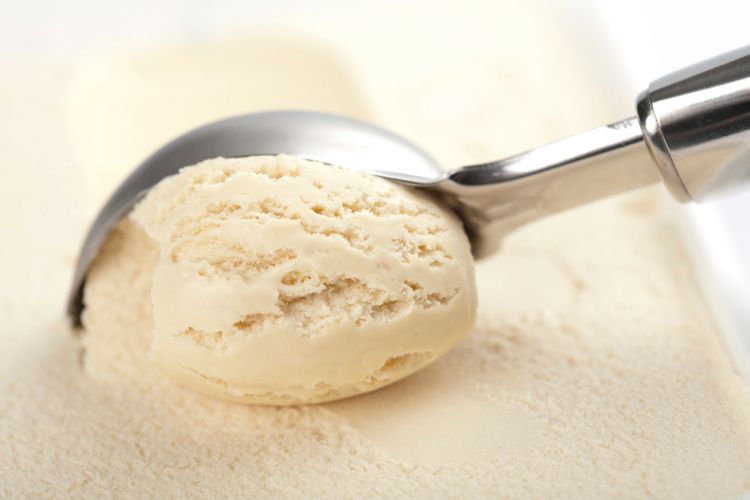
How Sweet It’s Not
Yes, one of the key characteristics of a healthy frozen dessert is a sugar level that’s dwarfed by what you’d find in a less-virtuous counterpart. Consider that a half-cup serving of Halo Top’s vanilla bean ice cream has 6 g of sugar compared to the 20 g you’ll find in both Häagen-Dazs and Ben & Jerry’s vanilla varieties, or the 13 g in Dreyer’s Slow Churned vanilla bean.
But the trend in healthy frozen desserts isn’t just about keeping sweetener grams low; attitudes about sweetness perception are changing, too.
Says Maxwell, “It’s interesting what’s going on with sweetness levels in frozen desserts. A lot of people don’t want their treats to be overly sweet, and the range of alternative sweeteners makes it easier for brands to create products at sweetness levels that don’t overwhelm-and, again, give the impression to the consumer of a healthier product.”
He believes that as the crop of clean-label alternative sweeteners gains greater consumer acceptance, and as products ratchet down sugar levels of the past, “consumers’ openness to a range of sweetness levels will create opportunities for other brands to provide a range of flavors and sweetness levels.”
Photo © iStockphoto.com/hidesy

Good Things Come in Single-Serve Packages
Less sugar, more protein, and a “clean” deck of ingredients qualify a frozen dessert as healthy. But so, too, does a serving size that makes it easier for consumers to exercise restraint. After all, even too much Halo Top is…too much.
So one way that brands are helping consumers make healthier choices is by delivering frozen desserts in formats with an obvious endpoint. Maxwell notes that his team has worked with frozen-dessert customers in developing a range of different formats, “but primarily on the smaller pint sizes” that are just right for a single-serve treat.
And when asked what formats she thinks help consumers know when it’s time to stop, Nina Hughes Likins, global marketing director, Prinova (Carol Stream, IL), says, “All of them! Popsicles, ice cream bars, pushups, sandwiches, and single-serve products have all been innovations that resonate with consumers’ demand for a healthier version of frozen desserts and ice cream.” And one that lets you know that when you’re done, you’re done.
Photo © Shutterstock.com/HandmadePictures
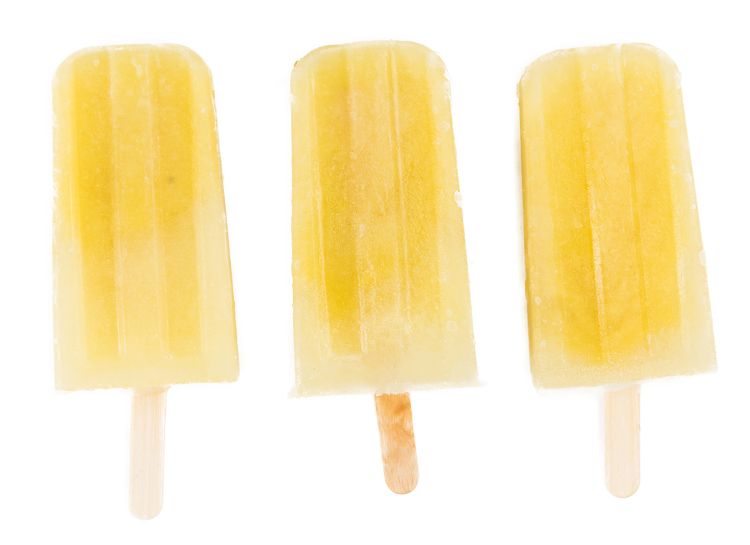
From Idea to Ice Pop
“Overall, the healthy frozen-dessert category continues to innovate to help consumers enjoy better-for-you indulgences that meet developing demand for global tastes,” Rexroat concludes.
To bring this notion to life in on-trend, on-the-go applications, USDEC, in partnership with the Midwest Dairy Foods Research Center at the University of Minnesota, developed a prototype for the 2018 Institute of Food Technologists Annual Meeting & Food Expo that blended nutritional benefits from domestic dairy with “the international flavor profiles consumers desire,” she said.
The concept: a lemon-ginger ice pop with whey protein (not pictured). “An adult spin on a classic kid treat,” as Rexroat describes it, the novelty packed 10 g of protein from U.S. whey protein isolate and fewer than 100 calories per pop. “It would make a great, portable option for healthy snacking between meals or post-workout,” Rexroat suggests.

Prinova acquires Aplinova to further increase its footprint in Latin America
April 7th 2025Prinova has recently announced the acquisition of Brazilian ingredients distributor Aplinova, which is a provider of specialty ingredients for a range of market segments that include food, beverage, supplements, and personal care.


